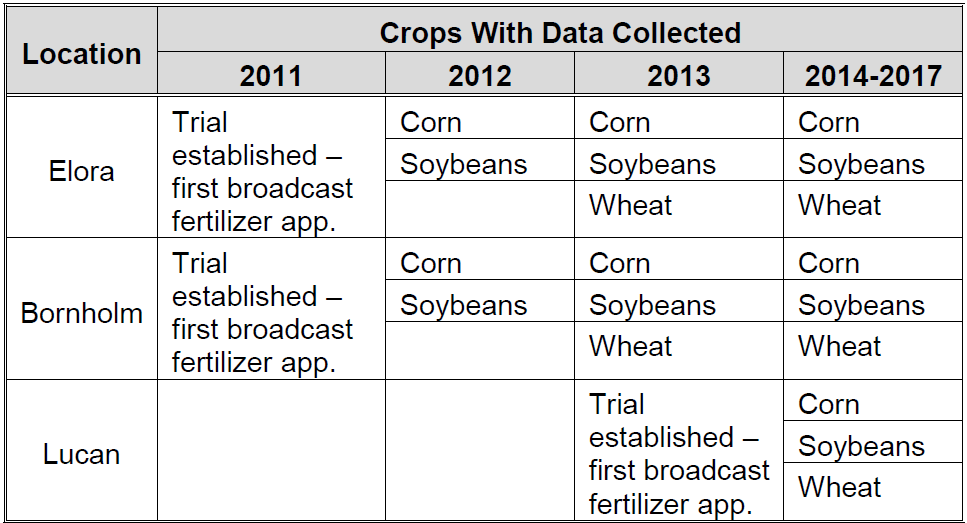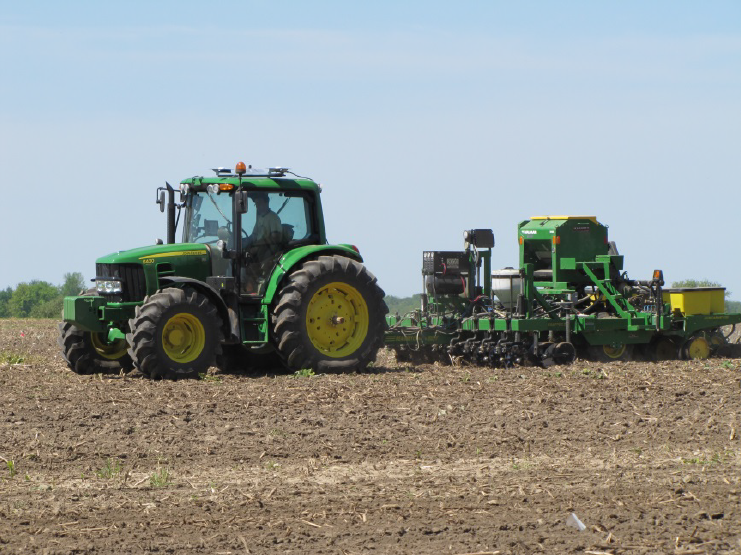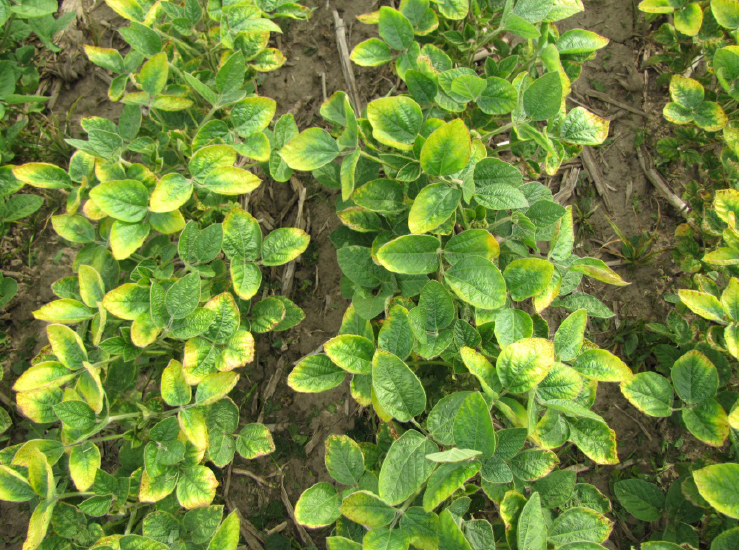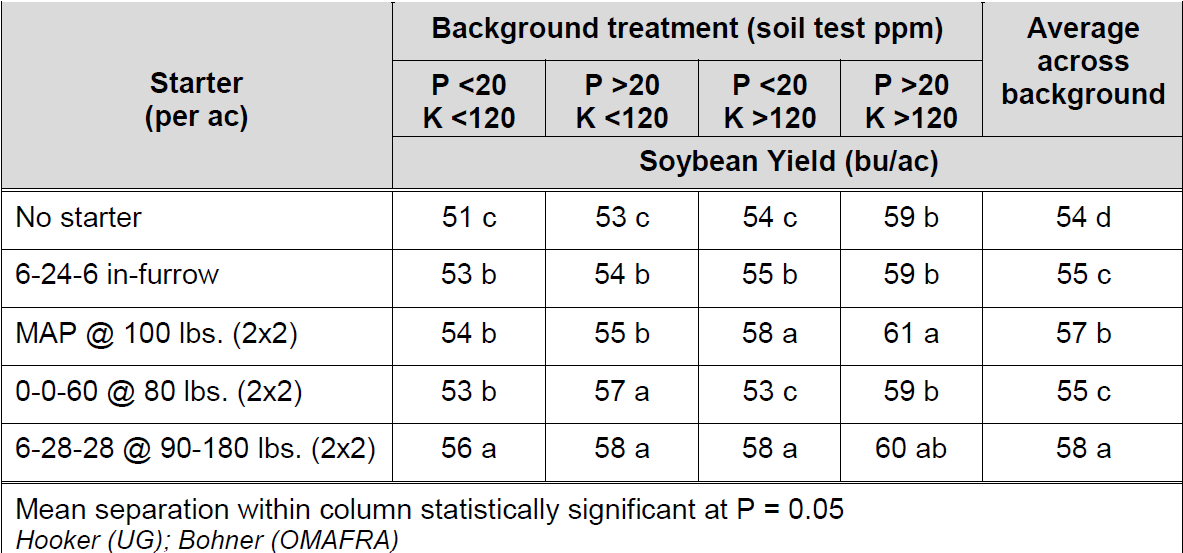Purpose
There is concern that the current OMAFRA recommendations do not adequately provide for modern crop yields. Since 1981 corn yields have increased by 80%, soybeans by 35%, and winter wheat by 65%. The OMAFRA recommendations are based on the sufficiency approach which aims to supply the needs of the current crop by taking into consideration the soil test and the immediate economic return to applied P and K. This approach does not aim to build the soil test to any given value. It is also called the “feed the crop” approach. Another strategy to fertilizer recommendations is to “feed the soil”. This method is called the “build and maintain” approach. Building phosphorous and potassium levels in soil represents a significant expense to growers, and can pose economic (ie. land rental) and environmental (phosphorous runoff) risks if soil test values are built excessively high. The sufficiency approach also poses risks because it may not supply adequate nutrients in a year with high yield potential. It also does not allow for a grower to mitigate environmental risks by managing application timing throughout the cropping rotation. For instance applying all the nutrients for a crop rotation in the summer after winter wheat harvest mitigates losses due to spring or fall run offs. This research is being conducted to investigate how starter fertilizer selection (product, rate) and the soil fertility management strategy (sufficiency or build and maintain) influences the economics and productivity of corn, soybeans and wheat over the long term.
The objectives of this project are to i) identify which fertilizer rates and application methods maximize net returns during the year of application and to ii) identify over the longer term whether meeting fertilizer recommendations for a given fertilizer test will provide yield and net return equivalent to a build and maintain approach, particularly in a high yielding environment.
Methods
Two field scale sites were established in 2012 near Elora and Bornholm. A third site was secured in the fall of the 2013 season near Lucan. One additional site was established by the U of G at the Ridgetown campus. Each trial location is studying a three crop rotation that includes winter wheat, soybeans and corn. Table 1, below, outlines the current project timeline, including the years in which the OMAFRA trial locations were established and what crop yield data was collected.
Trials were positioned on relatively low fertility locations to ensure distinct contrasts can be developed between low and high fertility plots over time. Four soil fertility background treatments have been established to investigate the yield influence of building soil fertility. These include a control (no fertility building), a high soil P fertility treatment, a high soil K fertility treatment, and a high soil P and K fertility treatment. Soil P and K were built and maintained by annual applications of 0-46-0 and 0-0-60 as required to build and maintain soil test values in a non-responsive range (greater than 21 ppm P and greater than 120 ppm K). Starter fertilizers are being investigated by applying treatments ranging from no starter fertilizer, low rate liquid P and K starter fertilizers, high rate dry P, high rate dry K and high rate dry P and K starter fertilizers. The dry starter treatments represent the sufficiency approach to fertilizer management since they supply adequate fertilizer for the given crop. Yield interactions between soil fertility (build and maintain) and starter fertilizer (sufficiency approach) will be analyzed for productivity and economic efficiencies over several years.
Table 1. Timeline for site establishment and crop data collection across OMAFRA sites.

The broadcast fertilizer treatments to build the soil included the following:
- Control (no broadcast fertilizer)
- 0-46-0 @ 400 lbs/ac broadcast
- 0-0-60 @ 400 lbs/ac broadcast
- 0-46-0 @ 400 lbs/ac broadcast + 0-0-60 @ 400 lbs broadcast
The starter fertilizer treatments applied each year included the following:
- Control (no starter fertilizer)
- 6-24-6 @ 5 gallons/acre applied in furrow
- 6-24-6 @ 3 gallons/ac applied in furrow
- 11-52-0 (MAP) @ 100 lbs/ac applied in a 2x2 band
- 0-0-60 @ 80 lbs/ac applied in a 2x2 band
- 6-28-28 @ 90 lbs/ac applied in a 2x2 band
- 6-28-28 @ 180 lbs/ac applied in a 2x2 band
These treatments were randomized and replicated three times at each trial location. Each treatment was 10’ wide by 60’ long. Trials were planted with a Kearney 15" vacuum planter with a precision seed monitor. See picture #1. All harvesting was
completed utilizing a customized combine equipped with a batch weigh system and moisture tester.
 Image 1. 15” row unit planter equipped to apply both liquid and dry fertilizer.
Image 1. 15” row unit planter equipped to apply both liquid and dry fertilizer.
Results & Summary
- Soybean yields responded to a starter blend of P and K in low background fertility soils (P<20, K<120) by 5 bu/ac across the 21 site-years of this study. This confirms earlier findings that adding P and K fertilizer to soybeans on low testing soils increases yields. On “built” soils (P>20, K>120) soybeans showed very small or no response to starter fertilizer treatments. The highest yields were achieved with a built soil test value plus a starter treatment of P and K or just P fertilizer (table #2).
- On low background fertility soils liquid starter added 2 bu/ac, dry P added 3 bu/ac, K added 3 bu/ac, and a blend of P and K added 5 bu/ac compared to no starter fertilizer (table #2). Averaged across background fertility liquid starter added 1 bu/ac, dry P added 3 bu/ac, K added 1 bu/ac, and the P and K together added 4 bu/ac compared to no starter fertilizer.
- This study supports earlier findings that soybeans respond to starter fertilizers (sufficiency approach) when soil test levels are low. This study has shown that K by itself does not to maximize soybean yields, P is also critical when soil test P is low. This study also supports earlier findings that when soils are built starter fertilizers provide only small yield gains or none at all.
- Results to date demonstrate that the sufficiency approach (highest rate of starter P and K) yielded significantly less soybeans (4-5 bu/ac) than soils that have been built to moderate levels of P and K averaged across all sites. An economic analysis will be conducted in future years when the soil test values of the high soil fertility treatments have built to a reasonable level and the soils have had time to reach equilibrium.
 Image 2: Potash deficiency symptoms at the Elora site.
Image 2: Potash deficiency symptoms at the Elora site.
Table 2. Soybean yield response to background fertility and starter fertilizer. Average across 21 site-years.

Acknowledgements
We would also like to thank the Grain Farmers of Ontario, who provided financial support for this project. The access to tractors for these field projects from John Deere is greatly appreciated. This project was conducted in Partnership with Ben Rosser (OMARFA), Peter Johnson, and Dr. David Hooker (U of G).
